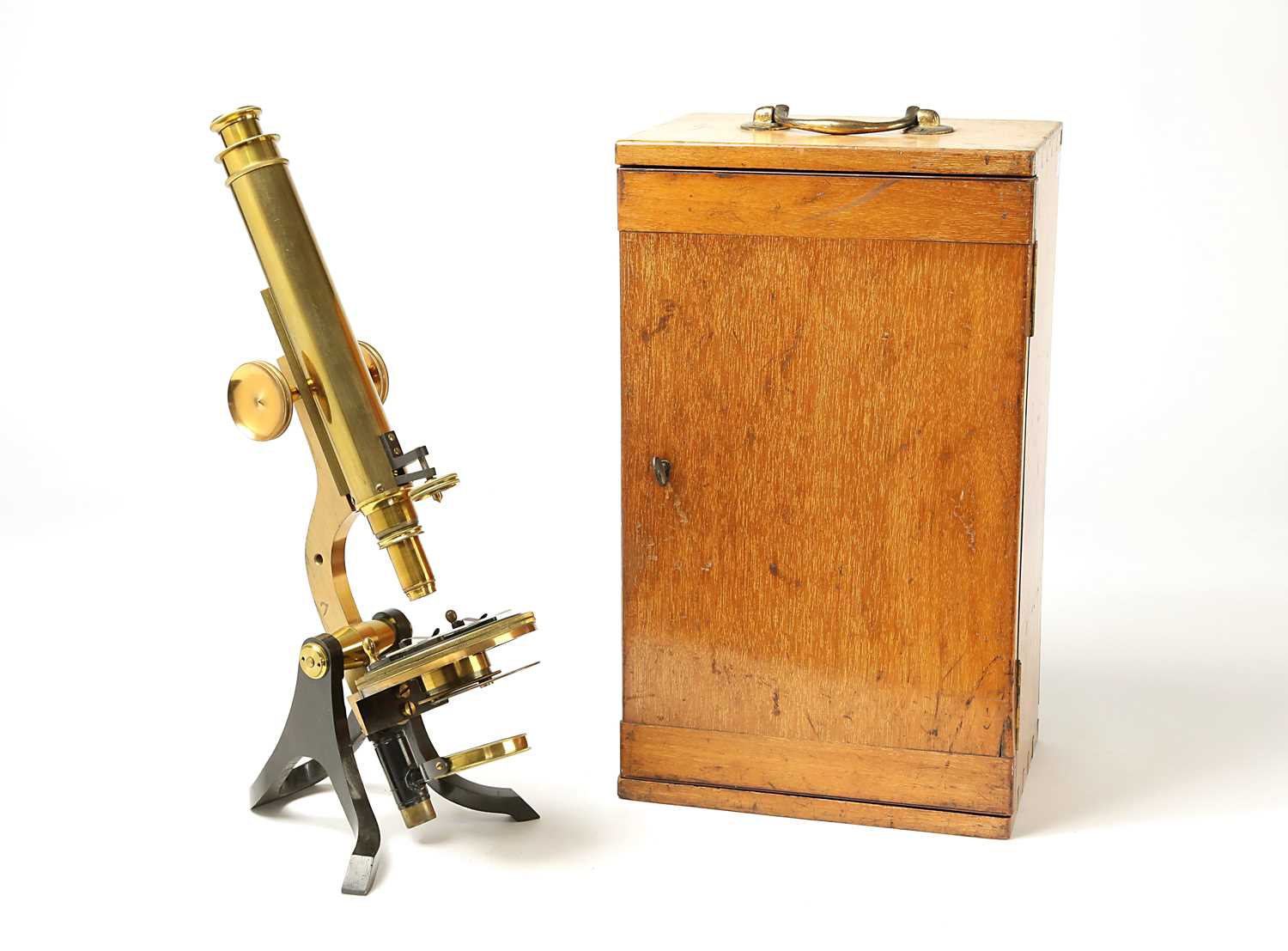1st May, 2000 12:00
Instruments of Science and Technology
67
A Henry Crouch Monocular Compound Microscope
A Henry Crouch Monocular Compound Microscope.
England, circa 1880.
Unsigned, the Lister-limb construction with rack and pinion and lever and screw focusing, mechanical stage, plano/concave reflector, in fitted mahogany case with bench condenser, two oculars, and three objectives.
Measurement: H. 40 cm.
catalogue Note: Henry Crouch learned his trade as an apprentice with Smith, Beck & Beck. The 1861 census records that the 22 year-old was still in that position. Henry left his masters and formed his own company, probably in early 1862. His younger brother, William, joined him. William does not appear to have been trained as an optical worker – the 1861 census listed him as being a “civil engineer”. The original H. and W. Crouch shop was located on Regent’s Canal Dock, Commercial Road, London, and their earliest instruments bear that address.
The Crouch brothers initially produced copies of the microscopes that Henry had made for Smith, Beck & Beck. They evidently realized that there was a limited market for knock-off mimics of high-end microscopes. The partners soon focused on producing good-quality, less-expensive microscopes for the middle-class microscopist and student.
Henry joined the Royal Microscopical Society in 1863, and the Quekett Microscopical Club in 1866. William does not appear to have become a member of those or any other microscopical society.
Henry and William exhibited twelve microscopes at the 1863 Annual Soiree of the RMS. This suggests that they may have been making several different models by that time.
Advertisements as early as September, 1864, indicated a move to 64A Bishopsgate Street. For several years afterwards, the Crouches retained the Regent’s Canal Docks location as their factory, although not as a retail location. Of known microscopes, number 170 is engraved with the Regent’s Canal Docks address, and 176 has the Bishopsgate Street address.
Henry and William exhibited instruments and accessories at the 1866 Dublin Exhibition, winning a Prize Medal for “excellence of microscope stands and objectives”, and an Honourable Mention for “cabinets”. They also exhibited “microscopes, object-glasses, &c.” at the 1867 Paris Universal Exhibition.
The Crouch brothers dissolved their partnership on February 27, 1866, with Henry retaining the optical business. The causes for the split between Henry and William are not known, although Henry’s training as an optical manufacturer and William’s as a civil engineer may have led them in different directions.
Estimate: 400-600
Sold for €390
A Henry Crouch Monocular Compound Microscope.
England, circa 1880.
Unsigned, the Lister-limb construction with rack and pinion and lever and screw focusing, mechanical stage, plano/concave reflector, in fitted mahogany case with bench condenser, two oculars, and three objectives.
Measurement: H. 40 cm.
catalogue Note: Henry Crouch learned his trade as an apprentice with Smith, Beck & Beck. The 1861 census records that the 22 year-old was still in that position. Henry left his masters and formed his own company, probably in early 1862. His younger brother, William, joined him. William does not appear to have been trained as an optical worker – the 1861 census listed him as being a “civil engineer”. The original H. and W. Crouch shop was located on Regent’s Canal Dock, Commercial Road, London, and their earliest instruments bear that address.
The Crouch brothers initially produced copies of the microscopes that Henry had made for Smith, Beck & Beck. They evidently realized that there was a limited market for knock-off mimics of high-end microscopes. The partners soon focused on producing good-quality, less-expensive microscopes for the middle-class microscopist and student.
Henry joined the Royal Microscopical Society in 1863, and the Quekett Microscopical Club in 1866. William does not appear to have become a member of those or any other microscopical society.
Henry and William exhibited twelve microscopes at the 1863 Annual Soiree of the RMS. This suggests that they may have been making several different models by that time.
Advertisements as early as September, 1864, indicated a move to 64A Bishopsgate Street. For several years afterwards, the Crouches retained the Regent’s Canal Docks location as their factory, although not as a retail location. Of known microscopes, number 170 is engraved with the Regent’s Canal Docks address, and 176 has the Bishopsgate Street address.
Henry and William exhibited instruments and accessories at the 1866 Dublin Exhibition, winning a Prize Medal for “excellence of microscope stands and objectives”, and an Honourable Mention for “cabinets”. They also exhibited “microscopes, object-glasses, &c.” at the 1867 Paris Universal Exhibition.
The Crouch brothers dissolved their partnership on February 27, 1866, with Henry retaining the optical business. The causes for the split between Henry and William are not known, although Henry’s training as an optical manufacturer and William’s as a civil engineer may have led them in different directions.
Estimate: 400-600
Auction: Instruments of Science and Technology, 1st May, 2000
Hessink's proudly presents the sale of a fine single owner collection of Instruments of Science and Technology. The sale offers you a great opportunity to purchase beautiful selection of globes, microscopes, telescopes, medical, drawing, surveying and navigational instruments from famous instrument makersfrom the 17th to the 20th century.
